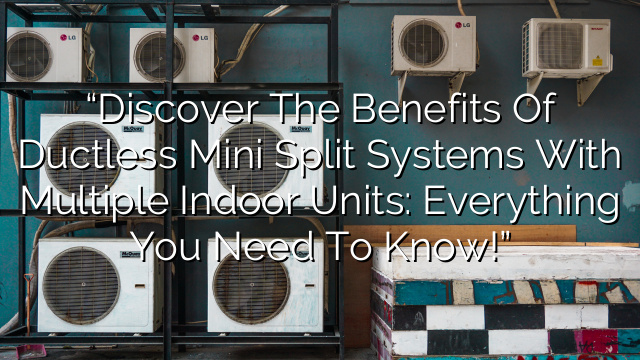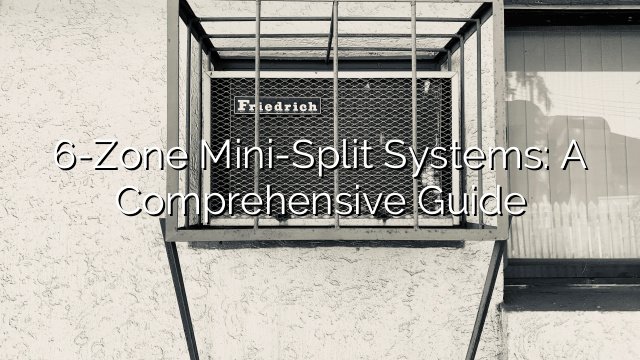Ductless Mini Split, 6 Zone 6 Room Mini-Split Systems: Everything You Need to Know!
If you are looking for an efficient and cost-effective way to cool or heat multiple rooms in your home, a ductless mini-split system with multiple indoor units is the perfect solution. With the ability to control each zone independently, you can enjoy personalized comfort in every room of your home.
In this article, we will discuss everything you need to know about ductless mini-split systems with multiple indoor units, including their benefits, installation process, and considerations. So, let’s dive in!
The Benefits of Ductless Mini-Split Systems
Ductless mini-split systems offer several advantages over traditional HVAC systems. Here are some key benefits:
- Energy Efficiency: Unlike central air conditioning systems that lose energy through ductwork, ductless mini-split systems deliver cool or warm air directly to each room. This eliminates energy loss and makes them more energy-efficient.
- Zoned Heating and Cooling: One of the main advantages of ductless mini-split systems is their ability to create different temperature zones in your home. With multiple indoor units, you can independently control the temperature in each room, saving energy and ensuring personalized comfort for everyone.
- Easy Installation: Ductless mini-split systems are relatively easy to install compared to traditional HVAC systems. They require no ductwork, which means less disruption and a quicker installation process.
- Improved Indoor Air Quality: Ductwork can accumulate dust, allergens, and other contaminants over time. With a ductless mini-split system, you won’t have to worry about dirty air ducts. Additionally, many models come with built-in air purifiers and filters to further improve indoor air quality.
- Flexible Design: Ductless mini-split systems offer a flexible design that blends seamlessly with any home decor. The indoor units can be mounted on walls, ceilings, or even recessed into the ceiling for a sleek and unobtrusive look.
- Remote Control: Most ductless mini-split systems come with a remote control that allows you to easily adjust temperature settings and other features from anywhere in the room.
The Installation Process
The installation process for ductless mini-split systems involves a few key steps:
- Determining the Number of Zones: Before installing a ductless mini-split system, it is important to determine the number of zones or rooms you want to heat or cool. Each zone will require an indoor unit.
- Locating the Outdoor Unit: The outdoor unit of a ductless mini-split system should be installed in an area with good airflow and minimal obstructions. It is typically mounted on brackets on an exterior wall.
- Installing the Indoor Units: The indoor units are connected to the outdoor unit through a small hole in the wall. They can be mounted on walls, ceilings, or recessed into the ceiling, depending on the design and layout of your home.
- Connecting the Refrigerant Lines: The refrigerant lines connect the outdoor and indoor units and transport the refrigerant that cools or heats the air. These lines are usually insulated and can be run in the walls, ceiling, or attic.
- Electrical Wiring: Proper electrical wiring is crucial for the functioning of a ductless mini-split system. It is important to hire a professional electrician to ensure the system is connected safely and efficiently.
- Testing and Commissioning: Once the installation is complete, the system should be tested and commissioned to ensure it is working properly. This includes checking refrigerant levels, airflow, and temperature control in each zone.
Considerations for Ductless Mini-Split Systems
Before installing a ductless mini-split system, there are a few important considerations to keep in mind:
- Size of Indoor Units: The size of the indoor units should be chosen based on the size of the room they will be installed in. Proper sizing ensures efficient operation and prevents over or undercooling/heating.
- Noise Level: While ductless mini-split systems are generally quieter than traditional HVAC systems, some models may produce more noise than others. Consider the noise level of the indoor and outdoor units before making a final decision.
- Energy Efficiency: Look for ductless mini-split systems with high energy efficiency ratings. Energy-efficient models can help reduce your energy consumption and lower your utility bills.
- Maintenance: Like any HVAC system, ductless mini-split systems require regular maintenance to ensure optimal performance. Cleaning or replacing air filters, checking refrigerant levels, and scheduling professional inspections are all part of routine maintenance.
- Professional Installation: It is highly recommended to hire a professional HVAC technician for the installation of a ductless mini-split system. Professional installation ensures the system is set up correctly and safely.
Frequently Asked Questions (FAQs)
1. Are ductless mini-split systems more energy-efficient than central air conditioning systems?
Yes, ductless mini-split systems are generally more energy-efficient than central air conditioning systems. They eliminate energy loss associated with ductwork and allow for zoned temperature control, which can lead to significant energy savings.
2. Can I install a ductless mini-split system myself?
While it is possible to install a ductless mini-split system yourself, it is highly recommended to hire a professional HVAC technician. Proper installation is crucial for the system’s performance and longevity.
3. How do I clean the indoor units of a ductless mini-split system?
To clean the indoor units of a ductless mini-split system, simply remove the front panel and gently wipe down the surfaces with a soft cloth. You can also use a vacuum cleaner with a brush attachment to remove any dust or debris.
4. Are ductless mini-split systems suitable for large homes?
Ductless mini-split systems can be suitable for large homes, especially when multiple indoor units are installed to create different temperature zones. However, it is important to properly size and plan the installation to ensure efficient cooling and heating throughout the entire home.
5. Can a ductless mini-split system be used for both cooling and heating?
Yes, ductless mini-split systems are designed to provide both cooling and heating. They use a heat pump technology that allows them to reverse the refrigeration cycle, providing warm air during the colder months.
6. How long do ductless mini-split systems last?
With proper maintenance and regular inspections, ductless mini-split systems can last for 15-20 years or even longer. However, this may vary depending on factors such as usage, climate, and the quality of the system.
In conclusion, ductless mini-split systems with multiple indoor units offer a convenient and efficient solution for cooling and heating multiple rooms in your home. Their energy efficiency, zoned control, and easy installation make them a popular choice among homeowners. If you’re considering upgrading your HVAC system, a ductless mini-split system may be the perfect fit for your needs!




